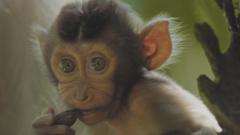9 minutes ago
About sharing
Arctic foxes are turning to cannibalism as they struggle to find food in a warmer world.
That’s one of the never-before-captured behaviours in Sir David Attenborough’s latest series – Mammals.
It focuses on how these animals are adapting to a world rapidly changed by the most dominant mammal – us.
We also see otters navigate the busy roads of Singapore and lemurs clinging to toothbrush trees in an attempt to keep cool in rising temperatures.
‘Mammals’ is a challenging series to watch but also shows the incredible ingenuity of the world’s most successful animals.
In the final episode of the six-part series Sir David says: “If we make the right decisions we can safeguard the future not just for our fellow mammals but for all life on Earth.”
The series comes 20 years on from the original Life of Mammals series. In that time the technology has moved on considerably allowing the BBC’s Natural History Unit and its partners to capture sequences they never thought possible.
The opening episode of the series has been shot completely in the dark – revealing how an African leopard uses its specially adapted eyesight to prey on sleeping monkeys.
“The thermal cameras now are stunning, the detail you can see. You can see the fur, you can see the whiskers of animals, so that technology has opened up that whole new world to us,” Scott Alexander, series producer, explained.
To capture some of the sequences the team have gone to extra lengths. For episode four, ‘Cold’, sleeping pods were specially designed so that the camera crew could remain out on the ice in Svalbard, Norway for days at a time tracking a polar bear.
As a result the team were able to capture a polar bear hunting reindeer inland – a behaviour they think it has developed as melting sea-ice has made it harder to hunt seals.
Assistant Professor John Whitman, from Old Dominion University and chief research scientist for Polar Bears International, who provided advice on the series said it: “illustrates the flexibility that polar bears try to have to replace the loss of opportunities to hunt marine, mammal prey.”
But he added studies have shown that this prey is not enough to replace the calories they need. “So, the most important action that can be taken to protect the species of polar bears [is] climate change action.”
For the first time the Natural History Unit filmed an African leopard hunting in the dark
In the two decades that have passed since the last series, what is also striking is the scale of human expansion. Since 2000 nearly 750,000 sq miles (1.9m sqkm) of habitat has been lost – about eight times the size of the UK – and one of the biggest causes is food production.
“Today almost half of the world’s habitable land is being used for agriculture. Across Southeast Asia vast palm oil plantations are replacing once pristine forests,” Attenborough warns us in episode two, ‘The New Wild’.
The destruction of the forests means there are dwindling food sources for local wildlife like pig-tailed macaques. But despite this, the episode brings us a remarkable story of their survival. A family of macaques are filmed entering palm oil plantations and capturing the rats that now live here.
“These pig-tailed macaques were predominantly vegetarian, and they are becoming carnivorous,” the episode’s producer Lydia Baines told BBC News.
“Animals are having to adapt in real time, essentially it is evolution in action. Darwin would be absolutely fascinated by this,” she added.
But not all of the mammals are so successful. In one episode we learn that rising temperatures in the Arctic have led to the sea freezing later in the year, and without sea ice the polar bears and arctic foxes cannot hunt. For one fox the wait is too long and the crew speculate he has died from starvation – hunger drives the other foxes to feed on him.
In another devastating scene baby howler monkeys are left orphaned as their parents are electrocuted after mistaking electrical wires for tree branches.
As well as being heartbreaking, the filming of the animals did bring scientific breakthroughs.
Dr Christine Cooper, a senior lecturer in animal physiology at Curtin University, Perth worked with the BBC Natural History Unit to help track echidnas for episode five. Whilst fitting transmitters on the animals for the series they were heard making sounds to each other underground – a phenomenon only heard once before and not captured on tape.
The discovery led to a new scientific paper from Dr Cooper and her team. She says the research is vital if we want to protect animal species.
“So if we understand how animals work and how they meet all their requirements, then we have an idea of how they might respond to a changing world. Then we can also take steps to conserve species,” she explained.
The series returns to some of the mammals filmed in the original series to see how human interventions are helping them to survive.
The blue whale was critically endangered until a whaling ban allowed their numbers to recover. ‘Mammals’ explores how they now face a new threat from shipping traffic, but work by scientists to track them is helping to put safety measures in place like low speed lanes.
Scott Alexander says this shows how we can work together with mammals to help each other.
“I think for me the message [of the series] is the planet is remarkable, let’s do what we can to protect the planet, live alongside these animals and share in this incredible diversity,” he said.
Mammals begins on BBC One at 19:00 BST on Sunday.
Related Topics
16 November 2023
13 February
